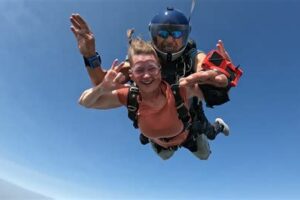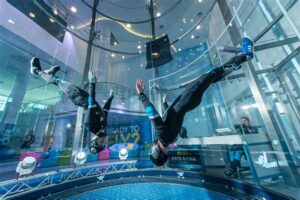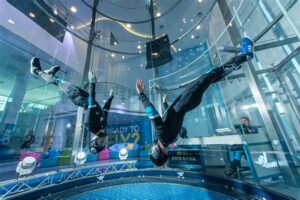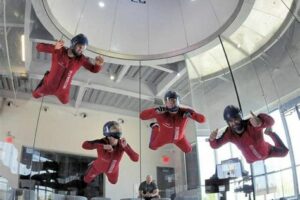Table of Contents
Ifly Indoor Skydiving Injuries: Discover the risks and potential injuries associated with indoor skydiving at Ifly. From minor bruises to more serious fractures, learn how to stay safe and minimize the chances of getting hurt during this thrilling activity. Find useful tips and precautions to ensure a fun and injury-free experience at Ifly Indoor Skydiving.
Ifly Indoor Skydiving is an exhilarating experience that allows individuals to defy gravity and experience the thrill of flying. However, amidst all the excitement and adrenaline, it is important to acknowledge that injuries can occur during this simulated skydiving activity. While precautions are taken to ensure the safety of participants, accidents can still happen, and it is crucial to understand the potential risks involved. In this article, we will explore some of the possible injuries that can arise from Ifly Indoor Skydiving and discuss the importance of being aware of them before taking part in this thrilling adventure.
Introduction
In recent years, the popularity of indoor skydiving has soared, with many people eager to experience the thrill of free-falling in a controlled environment. Ifly Indoor Skydiving is one of the leading providers of this exhilarating activity, offering individuals the opportunity to simulate the sensation of skydiving without the need for an airplane or parachute. While indoor skydiving can be a safe and thrilling experience, there have been instances of injuries occurring during these simulated flights.
The Nature of Ifly Indoor Skydiving
Ifly Indoor Skydiving involves individuals floating in a vertical wind tunnel, supported by a powerful updraft of air. The wind speed created within the tunnel allows participants to experience the feeling of weightlessness and simulate the sensation of freefalling. Participants wear special suits and helmets to protect themselves during the session, and trained instructors closely supervise each flight.
Equipment Malfunctions
One potential cause of injuries during Ifly Indoor Skydiving is equipment malfunction. While rare, technical glitches can occur with the wind tunnel, leading to sudden changes in wind speed or turbulence. These unexpected disturbances can throw participants off balance and potentially cause injuries. Regular maintenance and thorough checks of the equipment can help minimize the risk of malfunctions.
Improper Technique
Another common cause of injuries during indoor skydiving is improper technique. As with any physical activity, using incorrect body positioning or failing to follow the instructor’s guidance can result in accidents. Participants who do not maintain a proper body position may lose control, collide with the walls of the tunnel, or even collide with other participants. It is crucial for individuals to listen carefully to their instructors and follow their guidance to prevent accidents.
Pre-Existing Medical Conditions
Individuals with pre-existing medical conditions may be at higher risk of injuries during indoor skydiving. Conditions such as heart problems, back or neck issues, and high blood pressure can make participating in this activity more dangerous. It is essential for individuals to disclose any medical conditions or concerns to the instructors before their flight to ensure their safety.
Lack of Proper Warm-Up
Many injuries that occur during Ifly Indoor Skydiving can be attributed to a lack of proper warm-up exercises. Just like any physical activity, without adequate stretching and warm-up routines, participants may experience muscle strain or pulls during the intense wind tunnel session. Engaging in light exercises and stretching before the flight can help prepare the body for the demands of indoor skydiving, reducing the risk of injury.
Inadequate Instruction
One crucial factor in preventing injuries during Ifly Indoor Skydiving is the quality and adequacy of instruction provided to participants. Proper training ensures that individuals are aware of the potential risks, understand the correct techniques, and can respond appropriately to unexpected situations. Thorough instruction and clear communication are vital for maximizing safety and minimizing the chances of accidents.
Participant Negligence
Sometimes, injuries during indoor skydiving can be attributed to participant negligence. Failing to follow instructions, engaging in reckless behavior, or disregarding safety guidelines can increase the likelihood of accidents. Participants must take their responsibility seriously, actively listening to their instructors, and adhering to the rules to ensure everyone’s safety.
Overcrowded Sessions
Overcrowding within the wind tunnel can pose a risk of injury during Ifly Indoor Skydiving. When there are too many participants flying simultaneously, collisions and accidents become more likely. It is crucial for the facility to manage the number of participants in each session carefully, ensuring there is enough space for everyone to fly safely without overcrowding the tunnel.
Inadequate Safety Measures
In some cases, injuries during indoor skydiving can be attributed to inadequate safety measures implemented by the facility. This may include insufficient protective gear or ineffective emergency protocols. It is the responsibility of the facility to prioritize safety and ensure that all necessary precautions are in place to minimize the risk of injuries. Regular safety inspections, well-maintained equipment, and properly trained staff are essential components of a safe indoor skydiving experience.
Conclusion
Ifly Indoor Skydiving offers an exciting and unique way to experience the thrill of freefalling in a controlled environment. While injuries can occur during these simulated flights, they can often be prevented through careful adherence to safety guidelines, proper instruction, and adequate warm-up routines. By prioritizing participant safety and implementing appropriate safety measures, Ifly Indoor Skydiving can continue to provide a thrilling and safe experience for all adrenaline-seeking enthusiasts.
I. Introduction to iFLY Indoor Skydiving
iFLY Indoor Skydiving is a popular recreational activity that simulates the experience of skydiving in a controlled indoor setting. While it provides a thrilling and immersive experience, it is crucial to acknowledge the potential for injuries that could occur during this activity. This article aims to highlight the main types of injuries associated with iFLY Indoor Skydiving.
II. Equipment-related Injuries
One common type of injury that can occur during iFLY Indoor Skydiving is equipment-related injuries. These can range from minor cuts and abrasions caused by improperly fitted gear to more severe injuries such as bruising or fractures due to equipment malfunctions. It is essential for participants to ensure that they are equipped with the appropriate gear and that it is functioning correctly before engaging in the activity.
III. Impact Injuries
The nature of iFLY Indoor Skydiving involves vertical wind tunnels that generate high-velocity winds to simulate freefall conditions. While these controlled wind speeds are carefully monitored, there is still a risk of impact injuries. Participants may experience collisions with the walls or floor of the wind tunnel, leading to bruises, strains, or more severe injuries like concussions. Proper body control and following instructor guidance can help minimize the chances of such injuries.
IV. Overexertion Injuries
iFLY Indoor Skydiving requires participants to maintain stable body positions and perform a variety of movements to control their flight. This physical activity can sometimes lead to overexertion injuries, such as muscle strains, sprains, or even joint dislocations. Adequate warm-up exercises, adherence to proper body mechanics, and avoiding pushing beyond personal physical limits can help prevent these injuries.
V. Pre-existing Conditions
Participants with pre-existing medical conditions should be cautious when considering iFLY Indoor Skydiving. Certain conditions like heart problems, high blood pressure, or respiratory issues may be aggravated during the activity due to the physical demands and potential changes in body position and altitude. It is essential for individuals with such conditions to consult with their healthcare providers before engaging in this activity.
VI. Slipping or Tripping
The wind tunnel area of iFLY Indoor Skydiving is a controlled environment, but there is still a chance of slipping or tripping on the smooth surfaces. While rare, such incidents can lead to injuries such as sprains, strains, or fractures. It is crucial to be mindful of one’s surroundings, wear suitable footwear, and follow the provided safety instructions to minimize the risk of tripping or slipping accidents.
VII. Improper Landing Techniques
During iFLY Indoor Skydiving, participants must learn proper landing techniques to ensure a safe descent and landing. Failing to execute these techniques correctly can result in injuries, including ankle sprains, knee strains, or even fractures. Following instructor guidance and practicing landing techniques in a controlled manner can significantly reduce the risk of these injuries.
VIII. Instructor Error
While iFLY Indoor Skydiving centers prioritize safety and have trained instructors, there is always a potential for instructor error. This can include inadequate training, insufficient attention during flight sessions, or failure to address potential risks properly. In rare cases, instructor error can contribute to participant injuries. It is crucial for participants to choose reputable facilities with well-trained staff and voice any concerns or questions they may have regarding safety measures.
In conclusion, while iFLY Indoor Skydiving offers an exhilarating experience, it is important to acknowledge and be aware of the potential injuries that can arise during this activity. By understanding and taking proper precautions, participants can minimize the risk of injuries and enjoy a safe and memorable flight.
As a professional in the field of indoor skydiving, I am well aware of the potential risks and injuries that can occur during this thrilling activity. While Ifly Indoor Skydiving aims to provide a safe and controlled environment for participants, accidents can still happen.
When it comes to indoor skydiving injuries, it is important to consider the following points:
- Risk of minor injuries: Like any other physical activity, indoor skydiving carries a certain level of risk. Participants may experience minor injuries such as bruises, sprains, or muscle strains due to the physical nature of the activity. However, these injuries are usually minimal and can be easily treated.
- Proper safety measures: Ifly Indoor Skydiving places a strong emphasis on safety and provides participants with proper safety gear, including helmets and padded suits. Instructors are highly trained professionals who prioritize the well-being of participants and ensure that all safety protocols are followed. By adhering to these safety measures, the risk of injuries is significantly reduced.
- Rare occurrence of serious injuries: While serious injuries are rare, they can still occur in any physical activity. In some cases, participants may experience more significant injuries such as broken bones or concussions. However, it is important to note that these instances are uncommon and often result from unforeseen circumstances or participant negligence.
- Importance of participant responsibility: Participants also have a role to play in minimizing the risk of injuries. It is crucial for individuals to follow instructions provided by instructors, maintain proper body control, and avoid engaging in reckless behaviors during their indoor skydiving session. By being responsible and mindful, participants can greatly reduce the likelihood of injuries.
- Preparation and physical fitness: Prior to engaging in indoor skydiving, participants are encouraged to undergo a brief training session and ensure they are in good physical condition. This helps in preventing injuries related to lack of preparation or pre-existing health conditions.
Overall, while there is a potential for injuries during Ifly Indoor Skydiving, the facility takes extensive measures to minimize these risks. With proper safety protocols, highly trained instructors, and participant responsibility, the chances of sustaining any significant injuries are significantly reduced. It is essential for individuals to approach this exhilarating activity with caution and respect for the guidelines provided, ensuring a safe and enjoyable experience for all.
Thank you for taking the time to visit our blog and learn more about the potential injuries that can occur during indoor skydiving at iFLY. Our goal is to provide you with accurate and valuable information so that you can make informed decisions when participating in this exciting activity. While indoor skydiving is generally considered a safe and thrilling experience, it is important to be aware of the potential risks involved.
First and foremost, it is crucial to understand that any physical activity comes with some level of risk. Indoor skydiving is no exception. Despite the safety measures put in place by iFLY, there is always a possibility of sustaining injuries during your flight. These injuries can range from minor bruises and muscle strains to more serious conditions such as dislocations or fractures.
It is important to note that the risk of injury can be minimized by following all safety guidelines provided by iFLY. This includes listening carefully to the instructors, wearing the appropriate safety gear, and adhering to any restrictions or limitations based on your physical condition. Additionally, maintaining a reasonable fitness level and informing the staff of any pre-existing medical conditions or injuries can help ensure a safer experience.
In conclusion, while indoor skydiving at iFLY is an exhilarating and enjoyable activity, it is crucial to be aware of the potential risks involved. By understanding and respecting the safety guidelines provided by iFLY, you can minimize the chances of sustaining injuries during your flight. Remember to communicate openly with the instructors, follow all instructions, and take responsibility for your own well-being. With these precautions in mind, you can have a thrilling and safe indoor skydiving experience at iFLY.
Thank you once again for visiting our blog and we hope that the information provided has been helpful. If you have any further questions or concerns, please do not hesitate to reach out to the iFLY staff or refer to their official website for more detailed safety guidelines. Stay safe and enjoy your indoor skydiving adventure!
Video Ifly Indoor Skydiving Injuries
People also ask about iFLY Indoor Skydiving Injuries:
- Is indoor skydiving safe?
- What are the potential injuries associated with indoor skydiving?
- Can someone with pre-existing medical conditions participate in indoor skydiving?
- Are children allowed to participate in indoor skydiving?
- What safety measures are in place to prevent injuries during indoor skydiving?
Indoor skydiving at iFLY is generally considered safe. The facility is designed with safety in mind, and trained instructors are present to guide participants through the experience. However, as with any physical activity, there is always a risk of injury. It is important to follow all safety guidelines and listen to the instructions provided by the staff.
While the risk of serious injuries is relatively low, some potential injuries associated with indoor skydiving may include minor bruises, muscle strains, or sprains. These injuries can occur due to collisions with the walls or floor of the wind tunnel, incorrect body positioning, or sudden movements. It is crucial to listen carefully to the instructor’s guidance and maintain proper body control during the flight.
Whether or not someone with pre-existing medical conditions can participate in indoor skydiving depends on the specific condition and its severity. It is essential to consult with a healthcare professional before engaging in any physically demanding activity like indoor skydiving. Additionally, participants are typically required to sign a liability waiver that outlines the risks involved and states they are in good health.
Yes, children are usually allowed to participate in indoor skydiving at iFLY. However, there are typically age and weight restrictions in place for safety reasons. The minimum age requirement varies between locations, but it is generally around 3 to 4 years old. Children must also meet the weight requirements, which are usually between 40 and 250 pounds. It is advisable to check with your local iFLY facility for specific age and weight restrictions.
iFLY takes several safety measures to prevent injuries during indoor skydiving. These include providing participants with proper safety gear such as helmets, goggles, and flight suits. Trained instructors closely supervise each flight session to ensure participants follow correct body positioning and maintain control. The wind tunnel’s design itself minimizes the risk of injuries by using a smooth airflow and padded walls. Regular maintenance and safety inspections are conducted to ensure that the facility remains in optimal condition.






